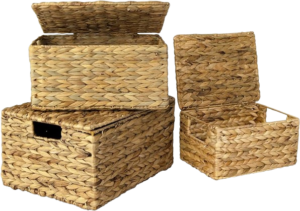Basket: A Timeless Fusion of Utility and Craftsmanship.
 A basket, a seemingly simple object, encompasses a rich tapestry of history, utility, and artistic expression. Crafted from diverse materials such as wicker, wood, metal, or plastic, baskets are versatile containers that have transcended time and culture. This discourse delves into the multifaceted nature of baskets, exploring their historical significance, cultural resonance, and practical applications.
A basket, a seemingly simple object, encompasses a rich tapestry of history, utility, and artistic expression. Crafted from diverse materials such as wicker, wood, metal, or plastic, baskets are versatile containers that have transcended time and culture. This discourse delves into the multifaceted nature of baskets, exploring their historical significance, cultural resonance, and practical applications.
Baskets Historical Roots and Utilitarian Essence:
Holder have been an integral part of human civilizations throughout history, serving essential functions in daily life. Woven from materials like willow, wicker baskets exemplify a traditional design, often equipped with sturdy handles for efficient carrying. Historically, these vessels were indispensable for gathering crops, transporting goods, and fulfilling various practical needs.
Cultural Significance and Artistic Expression:
Beyond their utilitarian roles, baskets hold cultural significance in many societies. Indigenous communities, for example, weave baskets as a form of artistic expression, incorporating symbolic patterns and designs. In the modern era, basket weaving has evolved into a celebrated art form, where traditional craftsmanship meets contemporary aesthetics, showcasing the enduring appeal of this ancient practice.
Domestic Elegance and Practical Organization:
In contemporary settings, baskets seamlessly blend practicality with elegance. From laundry baskets to picnic hampers, these vessels contribute to organized living spaces while adding a touch of charm. The adaptability of holders extends to gift-giving, where their attractive designs and reusable nature make them a popular choice for packaging and presenting items. Baskets, crafted from materials like wicker, wood, and metal, showcase a versatile design adaptable to various purposes and settings.
Historical Roots and Utilitarian Essence:
Holder, with their roots entrenched in the annals of human history, embody a harmonious blend of utility and craftsmanship. The evolution of basketry can be traced back through agricultural societies where these woven vessels played pivotal roles in harvesting and transporting crops. The enduring appeal of wicker, often derived from willow, lies in its flexible nature, allowing for the creation of robust containers equipped with handles for efficient use in various tasks. Beyond practicality, holder hold cultural significance, with indigenous communities expressing their identity through symbolic patterns and designs in woven artefacts.
Cultural Significance and Artistic Expression:
The humble creel transcends its utilitarian purpose to become a canvas for cultural expression. Indigenous communities, for instance, infuse their holders with symbolic patterns, colors, and intricate designs, creating artefacts that reflect both functionality and cultural identity. In the contemporary context, creel weaving has metamorphosed into an art form, with artisans seamlessly blending traditional techniques with modern aesthetics, showcasing the timeless beauty of this ancient craft. Creels seamlessly blend elegance with functionality, offering pragmatic storage solutions for household items, from laundry to picnic essentials.
Domestic Elegance and Practical Organization:
Within the confines of modern homes, baskets seamlessly marry practicality with elegance. From the functional simplicity of laundry creels to the sophistication of picnic hampers, these vessels contribute to the aesthetics of living spaces while providing pragmatic storage solutions. Furthermore, baskets, with their reusable and decorative qualities, have found a niche in the realm of gift-giving, where they serve as not just containers but as elegant packaging that adds to the allure of the presenting response to environmental concerns, baskets now utilize sustainable materials, contributing to eco-conscious living and aligning with contemporary values..
Sustainable Solutions and Contemporary Appeal:
In an era increasingly defined by sustainability, cases have found renewed relevance. Materials such as recycled plastic or eco-friendly fibers are now employed in basket weaving, aligning these timeless containers with contemporary environmental sensibilities. Their adaptability to changing times underscores their enduring relevance as both practical tools and eco-conscious choices. trig weaving has evolved into an art form, with artisans merging traditional techniques with modern aesthetics, showcasing the enduring beauty of this ancient craft.
Conclusion: In essence, the trig is not merely a receptacle for belongings; it is a symbol of craftsmanship, cultural identity, and practicality. Its timeless presence in various aspects of daily life reflects the enduring appeal of a simple yet indispensable container, weaving together the threads of history, culture, and functionality. In conclusion, the basket is a repository of human history, a canvas for artistic expression, and a functional yet elegant element of contemporary living. From the agricultural fields of antiquity to the modern gift-wrapped present, the trig has woven itself into the fabric of human existence, a testament to the enduring fusion of utility, craftsmanship, and cultural symbolism.

